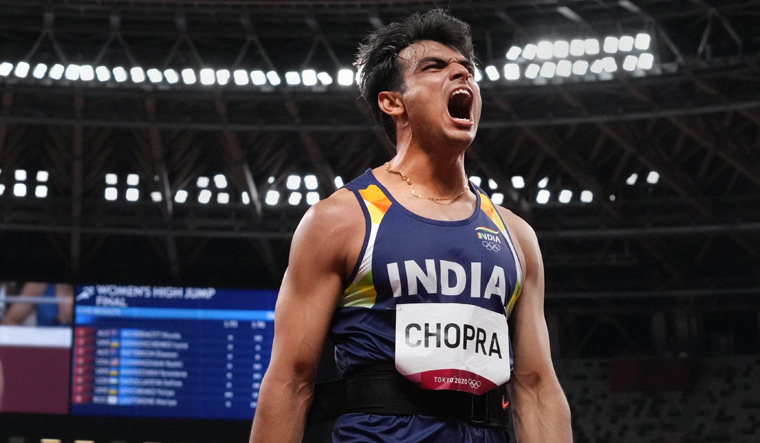After he ran in and released the Nordic javelin for the second time, Neeraj Chopra bent down to balance himself, turned around and raised his right hand to signal he had done it. He did not need to look where the spear had landed. Chopra had made the winning throw at the men’s javelin finals at Tokyo 2020.
For the record, the javelin had travelled 87.58m; no one would match the distance.
With this, the 23-year-old from Khandra village in Panipat, Haryana, walked into an exclusive club with only one other member—shooter Abhinav Bindra. They are India’s only individual Olympic gold medallists; Bindra won his at the 2008 Beijing Olympics. Chopra also became independent India’s first Olympic medallist in athletics; Norman Pritchard had won two silvers at the 1900 Olympics.
The achievement was enormous, but there was no jumping with joy. Subedar Neeraj Chopra was all understated swag. Simple, down to earth, humble. These are some of the words his mates, seniors, officials and coaches use to describe the golden boy. Athletics Federation of India president Adille Sumariwalla describes him thus, “A dedicated, well-behaved athlete totally focused on his game.”
Chopra is the reigning Asian Games, Commonwealth Games and now Olympic gold medallist. “What makes him different from other javelin throwers in India is his athleticism,” coach Klaus Bartonietz told THE WEEK from his home in Germany. “What he does in the gym, he does with speed. He is well coordinated on rope floor, high bar, parallel bars; you cannot compare with gymnasts, of course, but what is key is athleticism. This is what we need in javelin throw, all-round preparation.”
When it comes to his sport, Chopra is serious, committed and goes deep into the subject. But, like a lot of youngsters, he, too, loves his branded apparel. He also loves his long flowing hair, but had to chop it off while training in Sweden, weeks ahead of Tokyo. In food, he likes chicken and fish, and is partial to grilled salmon; he absolutely loves fruit juices.
Chopra’s talent was spotted much before he became the world junior champion in 2016. He was part of Mittal Champions Trust till 2012, but when that shut shop in 2014, he was brought into JSW Sports’s Olympic/high performance scheme. Said Manisha Malhotra, head of sports excellence and scouting, JSW Sports: “He is a hard worker, never shies from training harder. If you ask him to do certain things more times, he will always do so. He is very young but takes considered decisions when it comes to his sport—he will listen to all views and then decide what to do. He is very mature for his age. He is, in fact, an ideal athlete to work with.”
Malhotra had also worked with Bindra during her time as CEO of Mittal Champions Trust. “He [Chopra] is an optimist,” she said. “He did not take the [elbow] surgery (2019) as a huge setback; the only time he felt frustrated was when he was not getting competition abroad because of the second Covid wave in India. SAI (Sports Authority of India) and we were trying to get him abroad.”
SAI, through its Target Olympic Podium Scheme, had paid for Chopra’s travel, training and competitions, and his personal foreign coaches Gary Calvert (who died in 2018), Uwe Hohn and Bartonietz. JSW Sports had helped scout the right coach, had brought in physiologist Ishaan Marwaha and had supported Chopra through surgery, rehab and recovery. Said Bartonietz: “The effort [put in] post his surgery was more mental than physical. It was very tricky to increase the training load after surgery; the physio needed a lot of knowledge. Marwaha did a very good job; there is trust between the two. That is why we could increase the load week by week from basic exercises to lifting [weights]. [The progress in] such a relatively short time was amazing.”
JSW also worked with SAI to get Chopra to Europe ahead of the Olympics. He had been starved of competition in the lockdown, and eventually flew to Portugal. He was enrolled in several competitions and soon set up his training base in Sweden. The supportive role of the AFI, too, cannot be undervalued.
Dissecting Chopra’s throw, Bartonietz said: “If you break it down in terms of science, he had the highest velocity by amount and direction. Compare his 87.58m with the 86.67m of silver medallist Jakub Vadlejch of Czech Republic—the difference is 91cm, which is almost nothing at the 87m level. His (Neeraj’s) javelin was a little bit better in the air. He could focus. These guys (top javelin throwers) are very close in what they do; one is stronger, the other is faster, but Neeraj is a good technician. He threw the javelin 90m in training, which is a good result. We had set 88m as our goal before leaving for Tokyo.”
The European stint helped Chopra get into a good frame of mind. “We could train well in Sweden,” said Bartonietz. “The track, throwing field and gym were near each other. The mindset was to do our best. Our belief was that [German Johannes] Vetter was the best; we could not imagine that he would get troubled with technique in Tokyo, we thought he would go for gold. But Neeraj got his chance and, most importantly, he was able to use this chance. It was a mind game for all the top guys in Tokyo.”
For now though, it is time for Chopra to go back to his family, home-cooked food and some much-needed rest. Sponsorship deals and marriage proposals are pouring in, but these are not priority right now. So hectic were the hours after the win that he could not speak to his family until he arrived in Delhi. But his family is patient and so is he. A homecoming this special is a rarity.


